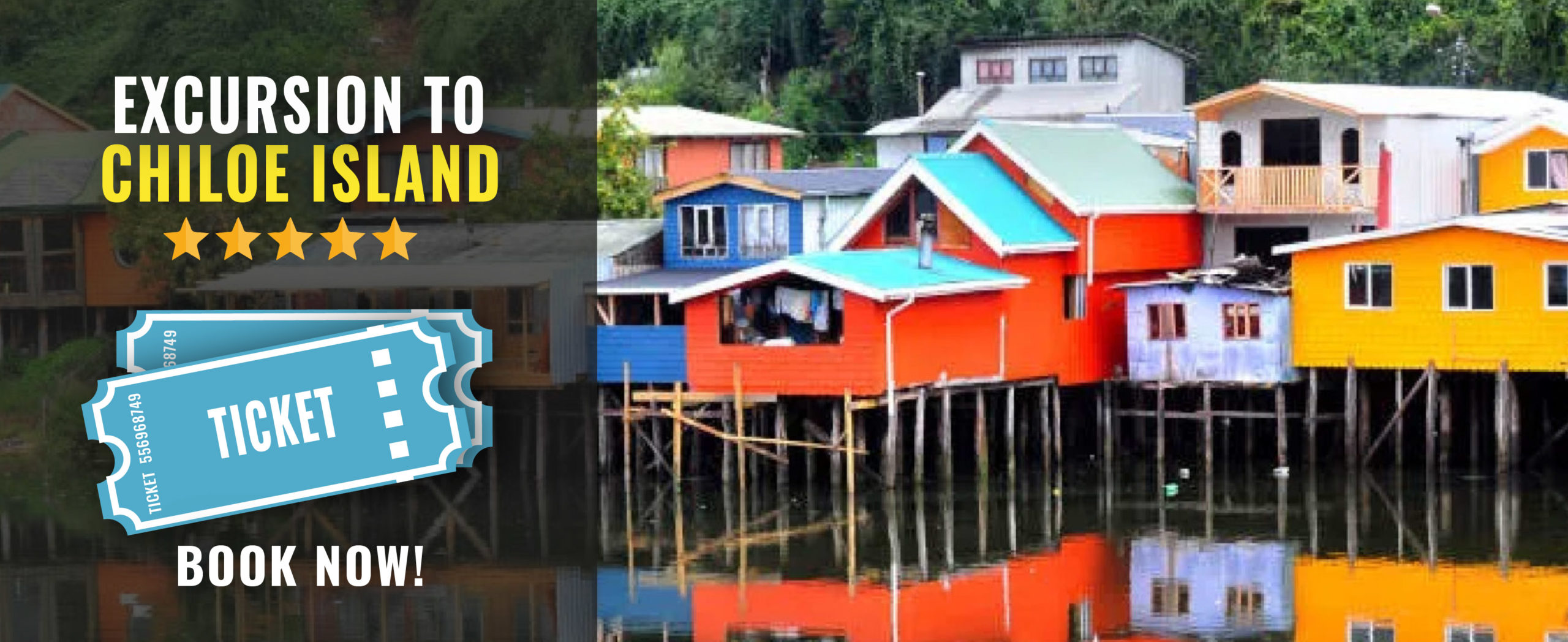The Chiloe Churches
The Chiloé churches are wooden temples built in the Chiloé archipelago, in the southern part of Chile, according to a traditional scheme that is considered to belong to a specific school of architecture in the region. These marvelous old buildings still standing date from the mid-18th century and the most recent ones from the first third of the 20th century.
A set of sixteen is considered a National Historic Monument of Chile and, since 2000, a World Heritage Site by UNESCO, which makes them a wonderful attraction for those visitors to the Island of Chiloé.
The Chiloe Churches: a bit of history
Of course, the Chiloe Churches are a must-see when you visit the island. But, let´s talk about the history first. Since the seventeenth century, the religious in charge of the evangelization of the islands were the Jesuits, who established a system called Circular Mission to take charge of all the evangelized communities. The circular Mission lasted 8 months and meant traveling a total of 4000 km by Dalca and on foot, but since they had to visit more than 80 sectors and face the adversities of the weather, the stay in each chapel lasted only a couple of days and during the rest of the year religious life was left to the prosecutor. In the early years of evangelization, the churches were rustic buildings with a thatched roof.
Due to the need to have more priests, the Company asked the King to allow the presence of Jesuits of nationality other than Spanish. The request was accepted and friars came from different parts of Europe, especially from Bavaria, Hungary and Transylvania. These foreign priests were the ones who, during the 18th century, gave impetus to the construction of more durable churches than their predecessors. They contributed the designs, inspired by the churches of their countries, and part of the construction techniques. For their part, the Chiloé carpenters contributed their own labor, materials and techniques, many of which were inspired by shipbuilding.
After the expulsion of the Jesuits, in 1767, missionary work was left to the Franciscans; However, the construction of temples continued to maintain the initial models and an architectural tradition maintained over three centuries was created, called the Chiloe School of religious architecture in wood. This tradition evolved over the years, going from a very ornate initial style to another, in the middle of the 19th century, much more sober, which has a certain resemblance to the European Baroque and Neoclassical.
Between 60 and 150 of the more than 400 churches spread throughout the archipelago belong to this school. Some, like that of Quilquico, have not withstood the passage of time and have fallen or had to be demolished, but others have stood for almost 300 years and are some of the oldest wooden constructions that remain in the world. planet. The need to preserve them meant that 16 of them were declared a National Monument and that in 1993, the Cultural Foundation Friends of the Churches of Chiloé nominated these 16 temples as candidates to be UNESCO World Heritage Sites. 14 of them were declared as such in the year 2000, and the inscription was extended to the remaining 2 (Churches of Chelín and Caguach) the following year.
The Chiloe Churches: Architecture
Chiloé churches follow a common basic structure with minor variations depending on the geographical area or the time of construction. The building is rectangular in shape with a gabled roof and occasionally three. The façade is usually on the east side and in front of it there is an esplanade for processions. In the most populated places, this esplanade has become the town square.
The façade consists of a portico adorned with false arches and a tower with a bell tower at the top. The usual number of arches is five, but some churches do not have them and others have seven or nine. Between the portico and the doors there is a space to shelter from the rain. The tower is usually octagonal in shape, with two or three bodies and in some cases it has an apse.
The interior is made up of three naves, separated by rows of pillars. On the portico there is a space for the choir. Usually the central nave has a concave roof, similar to the bottom of a boat. Some of the churches retain the pulpit.
The wood used to build these churches comes from the Chilote forest or the forests of the Palena province. The beams, the pillars and the internal cladding wood are made of hard and moisture resistant woods, such as cypress, coigüe or mañío. Luma wood dowels were used to join the larger portions; However, the widespread belief in the rest of Chile that Chiloe churches do not contain nails in their construction is not true, since they all have nails in their floors and in their exterior cladding. Outside the churches, larch tile cladding predominates, although tongue and groove boards were also used on the sides and zinc sheets on the roofs.

The Chiloe Churches: Unesco World Heritage sites
In December 2000, Unesco conferred the status of World Heritage Site to fourteen churches distributed in the Chiloé Archipelago. Later, on June 27, 2001, it added two other nominated churches to its World Heritage list.
Thus, the exceptional universal value represented by these monuments is recognized, characteristically built in wood and whose foundation dates back to the 18th century. The 16 Churches that make up the list are: Achao, Aldachildo, Caguach, Castro, Shilling, Chonchi, Colo, Dalcahue, Detif, Ichuac, Nercón, Quinchao, Rilán, San Juan, Tenaún and Vilupulli.
The Chiloe Churches
Church of Dalcahue – Nuestra Señora de los Dolores
The church of Dalcahue, also known as Nuestra Señora de los Dolores, is one of the oldest and largest in Chiloé, built in 1858 over the former Jesuit missionary chapel. It is clad on the outside with larch shingles and stands out for its portico, with nine arches, six pointed, two raised and the central one with a semicircle.
It has a portal with nine arches and a high tower that dominates the canal. Its interior, with three naves, has an altar with dressed wooden saints. The material used, for the most part, is cypress, larch and ulmo. The Church of Dalcahue is located in a place with a wide panoramic view, facing the channel that separates the Big Island from the Island of Quinchao, in front of the main square of the city. Construction of the current temple began at the end of 1893 and was completed in 1902, being blessed by the diocesan bishop on January 11, 1903.
Inside, the polychrome image of the Crucified Christ stands out, located in front of a red curtain. The figure has a hinge joint in the armpits, which would indicate that it was designed for the ceremony of the unlocking of Good Friday.
The patronal feast of this church takes place every September 15 in honor of Our Lady of Sorrows. Its measurements are 38.4 meters long by 17.1 meters wide and a tower of 26.5 meters. This construction was declared a National Monument in July 26, 1971, and declared a World Heritage Site by UNESCO, on November 30, 2000.
The Chiloe Churches
Church of Castro – San Francisco de Castro
The city of Castro was founded by Don Martín Ruiz de Gamboa, son-in-law of the Governor of the Kingdom of Chile, Don Rodrigo de Quiroga, who entrusted him with this mission, being baptized as Santiago de Castro in February 1567. That same year the first temple with the name of Apóstol Santiago was built, which would serve as the basis for the evangelization of the indigenous peoples of Chiloé, this temple was burned and rebuilt on several occasions until its destruction in 1771.
Since then, an old Jesuit temple has been used as a parish. There the Franciscans arrived from the Colegio de Chillán in 1768, and later, in 1711, those from the Colegio de Ocopa, Peru. In this place, one of the main sides of the square, the current San Francisco Temple rises majestically. Its construction, led by the superior of the convent of that time, Father Ángel Subiare, began in 1910 and ended in 1912.
The design is the work of the Italian architect Eduardo Provasoli. The temple was made by carpenters from Chiloé led by Salvador Sierpe. The work departs from the Chiloe tradition in some aspects: the design is the work of the Italian architect and combines a neo-Gothic and classic design with the local construction tradition.
In the structure, woods from the area were used, such as: larch, cypress, coigüe and other called “coloradas” in Chiloé. The interiors are made of raulí and olivillo. The front, the roof and exterior linings are made of galvanized iron. Inside there is an image of the archangel Michael victorious over Satan, of Saint Alberto Hurtado and a replica of the image of “the Nazarene” found in the church of Caguach. It is imposed in front of the Plaza de Castro with its 1,404 m2. 52 meters long, 25 meters wide and 16 meters high, it also has a dome over the presbytery of 32 m and the altitude of its towers is 42 m. The patronal feast of this church occurs every October 4, its patron is San Francisco. This construction was declared a National Monument in July 19, 1979, and declared a World Heritage Site by UNESCO, on November 30, 2000.
The Chiloe Churches
Church of Tenaun – Nuestra Señora del Patrocinio
The Church of Tenaún, also known as Iglesia de Nuestra Señora del Patrocinio, is located in the town of Tenaún (3 mountains in hulliche) in front of the square, in the Commune of Dalcahue.
The town was founded approximately in 1767 and the first news about its church appears in the circular mission plan from 1757 to 58; This was the chapel No. 67 that the Jesuit missionaries visited during their circuit. It was built in 1845 and has 3 towers (perhaps in honor of its location). It is considered an exception within the Chilota School of Religious Architecture in Wood for this same reason.
Its 42.40 meters long by 14 meters wide and its 26.10 meter high tower are built with cypress, mañío, cinnamon and hazelnut woods. Its exterior has undergone certain arrangements such as the change made in 1920 from shingle to galvanized iron. Our Lady of Patrocinio is the patron saint of the temple and her mass is held on January 30. This construction was declared a National Monument in August 10, 1999, and declared a World Heritage Site by UNESCO, on November 30, 2000.
The Chiloe Churches
Church of Colo – San Antonio
This building is located in the rural town of Colo, in the Commune of Quemchi. Its founding date dates from 1785, so it follows that it was not part of the Jesuit mission and its origin would therefore be Franciscan.
The current construction was carried out at the end of the 19th century, possibly around 1890, with coigüe and cypress woods and a stone base. Its portico has two-piece unworked log pillars, the arches are semicircular and the pediment is overlapping. The central nave has a semicircular arch vault and its pillars are columns with a cylindrical section and a base with ornaments. It is one of the most isolated and difficult to access churches in Chiloé. Unlike its peers, it is not near the sea and even turns its back on it, on top of a hill.
Its measurements are 27.7 meters long by 9.6 meters wide and a tower of 16.5 meters. Its Patron Saint, San Antonio, celebrates every June 13. This construction was declared a National Monument in 1999, and declared a World Heritage Site by UNESCO, on November 30, 2000.

The Chiloe Churches
Church of Ichuac – Natividad de María
Located at the western end of Lemuy Island, in the Commune of Puqueldón, this chapel was built in approximately 1880, with cypress, coigüe and larch wood. The first antecedents that we have of the history of Ichuac date from the 18th century, in “Registration of the Chiloé Mission from September 1734 to April 1735”, written by the Jesuit fathers, who left evidence of the existence in the town of Ichoac of 65 families, with 388 people, 266 confirmations, 8 marriages and 28 confessions of Spaniards.
The current Church was a work done by the community. It was blessed on December 8, 1880 on the occasion of the celebration of “La Purísima”, and according to the testimony of Don Juan Andrés Catelicán, the construction of the Church would have taken about 5 years and about 150 people would have worked there. The Church originally had two canes or upper bodies in its tower, which were rendered useless by the effects of the 1960 earthquake. In 1963 one of the canes was extracted, leaving the Church with its current appearance.
Its design includes a portico with one-piece pillars and pointed and lowered arches. Inside, the walls are painted white, while the ceiling remains with the natural color of the wood. As a curious fact at its entrance there is a painted clock that marks 3 in the afternoon. It is said to correspond to the time Jesus died or to mark the time of the 1960 earthquake. Its measurements are 31.9 meters long by 13 meters wide and a tower of 15.5 meters. Its patronal feast is held on February 2 in honor of the Virgen de la Candelaria. This construction was declared a National Monument in 1999, and declared a World Heritage Site by UNESCO, on November 30, 2000.
The Chiloe Churches
Church of Ichuac – Natividad de María
Vilupuli, in mapudugun means the hill of the serpent. There is evidence of its presence in writings from the early seventeenth century, when a town of Indians entrusted to Luis Pérez de Vargas is described, and more than a century later, in 1747, the commission was in charge of Miguel Fadrique Gallardo, according to the archives of the Royal Court.
The chapel that is currently located in the sector dates from the 19th century, although the architect and historian, Father Gabriel Guarda, stated that a part may well date from the late 18th century. nOn the other hand and according to a text compiled by the Bishop of Ancud, based on oral accounts collected in the sector, it is stated that the chapel was made by means of mingas, its construction beginning more or less in the year 1900. It is located in the town of the same name, north of the city of Chonchi, in the commune of the same name.
It is characterized by being located on a hill that looks directly at the Yal canal. Its measurements are 28 meters long by 12 meters wide and a tower of 18.80 meters. Its Patron is San Antonio and its festival takes place every June 13. This construction was declared a National Monument in 1971, and declared a World Heritage Site by UNESCO, on November 30, 2000.
The Chiloe Churches
Church of Detif – Santiago Apostol
The first Detif chapel was built in 1734. The current one was built in the center of town, near the beach, at the beginning of the 19th century. Coigüe and larch wood were used for its construction. The church was built on a stone base to protect it against the humidity of the soil, and lined with larch tiles. Due to the scarcity of metals on the islands of Lemuy and Chiloé, in the thick work, iron nails were not used, but wooden rivets.
Detif was the 15th place visited during the circular mission carried out between September 1757 and April 1758. His turn came after the missionary fathers visited Queilen. Later, after their stay in Detif, the parents visited Shilling. There is no history of this place in the Jesuit missions of the years 1736-1737 and 1775-1776, despite the fact that it had an active chapel in 1734 according to the historian Gabriel Guarda. The church has a tower composed of two bodies that rise above the façade. Like most of the traditional churches of Chiloé, the façade has a portico with five false arches that open onto an esplanade, an open space in front of the temple.
The interior is made up of three naves separated by lines of pillars; in it there are a large number of wooden boats hanging from the sky. These are votive offerings donated by sailors who returned alive. There are also restored clothing images of the Virgin of Candelaria and Jesus Nazareno. The church that belongs to the Diocese of Ancud has a very old bronze censer.
Its measurements are 26 meters long by 10.25 meters wide and a 15-meter tower. Its patron saint is the Virgin of Lourdes, the religious festival is celebrated on March 25. This construction was declared a National Monument in 1999, and declared a World Heritage Site by UNESCO, on November 30, 2000.
The Chiloe Churches
Church of Quinchao – Nuestra Señora de Gracia
In the southern area of the island of Quinchao, between the tips of Couquencura and Punta Matao, is the Nuestra Señora de Gracia de Quinchao church, in the sector and commune of the same name, about 10 kilometers from Achao. It was built during the 18th century, but its construction was completed in 1880. Today it is the largest church in the Chiloé Archipelago, measuring 53 meters long, 18.4 meters wide and having a tower of more than 18 meters.
The materials used to build it were cypress, cinnamon and hazelnut. Every December 8th in its facilities the Feast of Our Lady of Grace, patron saint of the temple, takes place. The church of Quinchao responds to the basic shape of the missionary church of Chiloé, made up of a large volume of horizontal proportions with a gabled roof and the end that faces the esplanade (open space that is located in front of the temple), is assembled with a vertical body, the facade tower; This architectural element, the most defining of the Chiloé churches, is composed of the entrance portico, the gable or pediment and the tower itself.
Since 1880, when the construction was completed, the building has received alterations in its shape and it is known that around 1906 it had to be partially rebuilt and on an undetermined date the exterior corridors were removed. In addition, after the 1960 earthquake, concrete foundations were added and perimeter wooden struts were added in 1993. This construction was declared a National Monument in 1971, and declared a World Heritage Site by UNESCO, on November 30, 2000.
The Chiloe Churches
Church of Nercon – Nuestra Señora de Gracia
Nercón, whose name means in the Huilliche language “between hills”, a design that is understood when observing its geography, was born from a group of indigenous people, supposedly displaced from the city of Castro by the Spanish.
The registration of the Mission of Chiloé, registers in 1734, 32 indigenous families, there being then no Spanish population.At first, the Chapel located towards the interior, apparently had a roof made of “tepe”, a plant from the Chiloé mountain range and, it is believed that its plans would be under a stone buried in the place of the main altar inside a bottle. Nercón, a distinctly indigenous town of the seventeenth century, was from the beginning dependent on Castro, in the administrative and religious order.
In 1879 the Bishop was asked for a license to rebuild the Chapel, since it was in a dilapidated state. That same year the works began, executed with such speed, that by January 1880, it was ready to be roofed. However, the completion works continue for a period of eight more years.
The building has not undergone formal alterations or relevant materials since 1890, the year in which the construction of the church was completed. Only occasional renovations of construction elements have been carried out.
Its date is approximately 1890, being built of cypress and larch wood. It preserves a large part of its Santeria, its sacristy and the interior paintings that imitate marble. Its tower has two octagonal drums and its spire is covered in tiles. The pillars are supported on bases and have semicircular arches. The vault of the central nave has a lowered arch. Inside, the figure of Saint Michael stands out with a demon at his feet that was carved from a single piece of wood and its interior painting that resembles marble.
Its dimensions are 37 meters long, 15 meters wide and a 25 meter tower. Its main festivals are the Virgen de la Gracia every September 8 and the Archangel San Miguel on September 29. This construction was declared a National Monument in 1984, and declared a World Heritage Site by UNESCO, on November 30, 2000.
The Chiloe Churches
Church of Chelin – Nuestra Señora del Rosario
In 1734, according to the Matricula de la Misión de Chiloé, the Jesuit fathers counted a total of 145 inhabitants in this town. It was the 17th place visited by the mission, and it corresponded to a “town of Indians with a chapel”. It is located on the island of the same name, past the Rilán peninsula, east of Castro, in the same commune. It is said that it was built in 1735, although the current church dates from 1888.
It is inspired by neoclassical styles formed by 6 conical columns that adorn a portal and its ceiling is covered with larch tiles. At the back of the church there is a characteristic Chilote cemetery with small wooden houses. What makes this chapel unique is that it shows the neoclassical style that prevailed in the archipelago when the traditional churches were erected, which can be seen in its decorations and in the imitation marble paintings. Inside it keeps a beautiful polychrome full-carved crucifix, as well as the image of Jesús Nazareno.
Its measurements are 30.8 meters long by 12.35 meters wide and a tower of 18.5 meters. The main festival celebrated is Our Lady of the Rosary every August 30. This construction was declared a National Monument in 2000, and declared a World Heritage Site by UNESCO in June 2001.
The Chiloe Churches
Church of Aldachildo – Jesus Nazareno
This church is located in the town of Aldachildo, on Lemuy Island, in the Commune of Puqueldón. It is believed that it was built in 1910 and the materials used were cypress, coigüe and larch for the lining. It has a tower with two octagonal drums and an octagonal spire. Its portico has one-piece pillars supported on bases and pointed and pointed arches, with an overlapping planked pediment. Its central nave has a vault and semicircular arches and column-shaped pillars.
Inside, its domed sky is blue and dotted with hundreds of tiny yellow stars. Between the arches that separate the central nave from the side aisles, it was decorated with exquisite flowers painted in red and yellow, giving it the appearance of a spring that never leaves the temple, even on the windiest days.
Its measurements are 29.5 meters long, 11.25 meters wide, and a total height of the tower of 18.5 meters. Its patron saint is Jesús Nazareno and its celebration is on August 30. This construction was declared a National Monument in 1999, and declared a World Heritage Site by UNESCO, on November 30, 2000.
The Chiloe Churches
Church of Rilan – Santa Maria
The first mention of Rilán dates from 1658, where it is said that there is a town of Indians with a chapel, whose commissioner was Pedro Gallegos. Around 1760 it is affirmed that it has a “good church” and then there are mentions in 1854 in writings of Governor Rondizzoni. The Church of Rilán, appears in the parish archive registered in 1903, being contemporary of the Franciscan Church of Castro, from which all the techniques, constructive solutions and new concepts of architecture of the area come.
It was entrusted to a group of teachers from the town of Curahue, near Rilán, who also built the chapels of Dalcahue, Curaco de Vélez, Quilquico and Yutuy, the latter of the same proportions as that of Rilán. At first, the Church was located in the place of the Plaza, which at the time of building the new one, was estimated to be about 100 years old.
The name of Rilán means “there is no pass”, a name that is understood from its location, at the end of this peninsula. It is located in the rural sector of the same name, in the commune of Castro. The current church was canonically erected on June 30, 1903 and was built between 1908 and 1920. The blessing of the first stone took place on January 12, 1908, the skeleton being ready that same year in August.
It is inspired by a neo-Gothic style that includes tile cladding, a front made of pillars and lowered semicircular arches with pointed arches, it stands out for its ribbed vault. The woods with which it was built are coigüe, cypress, larch and mañío, its interior lining is tepa and its base is stone. Its dimensions are 37.50 meters long by 15 meters wide and a height is 9.20 meters in its central nave, in addition, its tower measures 27.90 m. Its patron saint is Our Lady of Lourdes and its corresponding mass is held on February 11. This construction was declared a National Monument in 1971, and declared a World Heritage Site by UNESCO, on November 30, 2000.
The Chiloe Churches
Church of Chonchi – Nuestra Señora del Rosario
Chonchi is located where the Big Island narrows, on its eastern coast and opposite Lemuy Island; the Spanish called it “the end of Christianity.” The Jesuits chose this place to establish an outpost for their circular mission, covering the nearby sectors and the southernmost areas of the archipelago. The official foundation of the Villa San Carlos de Chonchi took place in 1767, by order of Governor Guill de Gonzaga; its first church was standing in 1769.
This temple is located in the heart of the city of Chonchi, in front of the Plaza de Armas. Its construction dates from 1893 and was made with stones and cypress as a base. Inside there is a great blue vault with a half arch dotted with white stars, outside there are pillars, arches and a decked pediment. Its measurements are 45 meters long by 18 meters wide and a 23-meter tower.
The main festival of this temple takes place every November 4 when San Carlos de Borromeo, patron of the church and the city, is remembered. This construction was declared a National Monument in 1971, and declared a World Heritage Site by UNESCO, on November 30, 2000.
The Chiloe Churches
Church of Caguach – Jesus Nazareno
The island of Caguach is undoubtedly the seat of the most important religious festival in the archipelago. On August 30 of each year the Feast of the Nazarene takes place, a day on which the island – of about 540 inhabitants a year – receives for a few hours the visit of more than 5,000 pilgrims.
When you disembark and look up, a white cross marks the path of the devotees and when you reach it you can see the extensive esplanade and in the background the great temple with its orange facade. Whoever visits the island at a time other than that of the great festival (which is repeated in January) is amazed at the great proportions of the church. However, during the days of the Nazarene, the temple becomes small to receive so many faithful.
Documentary data speak that before 1683 there was in Caguach a town of Indians entrusted to Doña María Collados and in 1734 a chapel is already mentioned. With the arrival of Father Hilario Martínez, a Franciscan from the Colegio de Ocopa, who brought the image of the Nazarene, a church 30 yards long by 12 wide was built in 1778, which was renovated in 1782.
A new temple was built in 1880, this time 56 yards long by 22 yards wide and a tower 32 yards high, with a 5-quintals and 60-pound bell cast in 1871. This church was destroyed by a fire that occurred on September 2, 1919 and the following day the people of Caguach began to erect the building that is currently preserved and which was completed in 1925. According to a technical sheet from the Faculty of Architecture of the University of Chile, the church is in good general condition and only the exterior cladding would be in fair condition.
The factory corresponds to the dominant constructive structural model in the Chilota School of Religious Architecture in Wood. Perhaps one of the elements that distinguishes it from the rest is that in the planking of its vault the boards have been arranged transversely, curving them.
The Chiloe Churches
Church of Achao – Santa Maria de Loreto
The Santa María de Loreto de Achao Church was built by the Jesuits in 1730 (it is one of the oldest in Chile). In 1780 it was almost completely destroyed by a fire that affected the area, but it had an outstanding reconstruction in 1784. It is located right in the Plaza de Armas of the city (Achao) and its access looks at the incredible sea that surrounds the island and that is only a few meters from this architectural marvel.
This church is 46 meters long, 14 wide and has a height (of its tower) of 22 meters. It is one of the largest on the island. As for the materials, it is covered by larch wood tiles, and inside, an onslaught of cypress and mañío. Its Catholic art is inspired by the Baroque period, with a central vault divided into five.
This church was declared a World Heritage Site by UNESCO in 2000. Regarding the feast and religious celebration, it is celebrated every December 10 in honor of Santa María de Loreto, the patron saint of the church.
What to do in Chiloe Island?
Well, if you decide to stay in Chiloe, you will find many great activities to do. But, you also can visit Chiloe Island in a full day trip from Puerto Montt or Puerto Varas, while you´re visiting the lakes district in the chilean Patagonia. Check our Full Day tour to Chiloe Island
Patagonia Tours: Visiting Chiloé, the Lakes District in Argentina and Chile
We have different options to visit the northern portion of Patagonia. Check the following list of Patagonia Tours, including Peninsula Valdes and the Lakes District in Chile and Argentina
Argentina and Chile in 12 nights – I: Buenos Aires, Bariloche, Puerto Varas, Santiago 
The Lakes District of Patagonia – 6 nights 
1-day Lakes Crossing from Bariloche to Puerto Varas 
1-day Lakes Crossing from Puerto Varas to Bariloche 
2-day Lakes Crossing from Bariloche to Puerto Varas 
2-day Lakes Crossing from Puerto Varas to Bariloche 
More tours to visit Chile!
If you´re looking for more tours to visit Chile, check our complete list of tours to visit Chile by clicking in the image below














